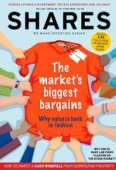Archived article
Please note that tax, investment, pension and ISA rules can change and the information and any views contained in this article may now be inaccurate.
Is smart beta a smart bet?

‘Smart beta’ is gaining traction as a method of index investing as investors adopt a growing range of strategies that have been used to generate outperformance by active managers for years.
Some $6bn flowed into smart beta exchange-traded funds (ETFs) in Europe last year, taking total assets under management to $46bn, data from BlackRock shows.
The asset manager’s ETF subsidiary iShares points to three trends catapulting smart beta into the mainstream: lower returns for longer, cost consciousness and advances in portfolio construction.
‘We expect appetite for smart beta strategies to continue to increase as investors seek improved investment outcomes beyond what traditional market cap weighted indices can offer,’ says Anthony Kruger of its specialist sales team.
One such investor is Jim Mackie, an investment director in Brooks Macdonald’s London-based multi-asset team. It is actively looking to add smart beta strategies to its passive model portfolios.
‘Firstly, the available products may enable us to express a particular investment view in a cost effective manner which may, in turn, differentiate our portfolios from more mainstream offerings,’ he says.
‘Secondly, we believe it makes sense where possible to use funds that have a proven track record of outperforming their benchmark index in both upward and, more importantly, downward markets.’
WHICH PRODUCTS ARE POPULAR?
Also known as ‘alternative beta’ or ‘factor investing’, smart beta recognises that passive investing relative to a market capitalisation weighted index may not be the best approach and that other metrics should be used instead. Popular funds include those that equally weight stocks in an index or focus on factors like low volatility, high yield, value, growth, quality, momentum and size.
London-based Capital Asset Management, a long-term proponent of passive investing, favours the Dimensional UK Value (GB0033771659) and Dimensional UK Small Companies (GB0033772061) funds to tilt holdings towards value stocks (companies that are cheap relative to fundamentals) and small and mid cap stocks.
‘There is now a significant body of academic research that supports the view that factors such as small cap, value and profitability are likely to deliver above broad market returns over the longer term,’ says its chief executive Alan Smith.
‘This seems to make intuitive sense on a risk/reward basis in that smart beta investors are effectively taking more risk than broad market investors and would, therefore, expect a greater return.’
Canaccord Genuity Wealth Management used the UBS MSCI USA Value ETF (UC07) to get exposure to the under-owned and unloved US value space earlier this year.
While Thesis Asset Management does not currently have any explicit core smart beta allocations, it makes long-term allocations to take advantage of historically outperforming factors like momentum. Simply buying more of what has already done well has provided more than double the return of the MSCI World index over the last 30 years (2,473% versus 945%), according to portfolio manager Adam Burniston.
Kruger at iShares believes momentum will continue to do well against the current backdrop of strong earnings momentum and a solid global growth outlook.
‘We’ve seen particularly strong flows into risk-on factors like momentum and expect this trend to continue in the current environment,’ he says.
While momentum tends to perform best in expansions, it has also proved resilient in slowdowns. During the sharp downturn in developed market equities in February, the relative performance of momentum strategies held up well: momentum outperformed the broader US equity market by 0.1% and global equities by 0.64% during the eight worst trading days.
JUMPING ON THE BANDWAGON
Criticism of smart beta centres on the growing complexity of products and difficulty in timing switches from one strategy to another as market conditions change.
‘Investors are having to become smarter to understand what they’re investing in,’ says Justin Oliver, deputy chief investment officer at Canaccord Genuity.
He points to a torrid time for low volatility ETFs during February’s downturn. Designed to suffer less in the event of a correction, many lost more than the broader market.
The problem with smart beta is the reliance on past risk data and investors chasing the latest fashionable strategy in the same way they plough into ‘hot’ stocks or ‘star’ fund managers. Former low volatility stocks tend to become more volatile as money flows into them and their valuations increase.
Avoiding the herd mentality is one way around this situation. ‘Arguably, the smart beta products that should be of most interest to investors are those that have performed poorly, because they are more likely to come into vogue,’ says Oliver.
Diversifying across a range of factors, either through a number of stand-alone strategies or a multi-factor fund, and taking a long-term view are other routes to consider.
‘The key is time horizon,’ says Smith. ‘Most factor strategies are expected to play out over the longer term; this can mean ten years and beyond. The challenge in the short-term obsessed investment market is to stick to strategy and not bail out at the first sign of underperformance.’
Others, however, remain vehemently opposed to so-called ‘smart beta’. ‘It’s not a smart bet; we don’t gamble with clients’ money,’ says Richard Stammers, chief investment strategist at European Wealth. ‘There may be a lot of these products, but it doesn’t make any of them any good. It just means lots of people have jumped on the same bandwagon.’ (JH)
Important information:
These articles are provided by Shares magazine which is published by AJ Bell Media, a part of AJ Bell. Shares is not written by AJ Bell.
Shares is provided for your general information and use and is not a personal recommendation to invest. It is not intended to be relied upon by you in making or not making any investment decisions. The investments referred to in these articles will not be suitable for all investors. If in doubt please seek appropriate independent financial advice.
Investors acting on the information in these articles do so at their own risk and AJ Bell Media and its staff do not accept liability for losses suffered by investors as a result of their investment decisions.
Issue contents
Big News
- BT in charm offensive to get investors back onside
- Markets are climbing the ‘wall of worry’
- Battle for control at Stobart and Petropavlovsk
- What does the Government sale of RBS stake mean for investors?
- Why Hotel Chocolat continues to be a sweet investment
- Bodycote boom time raises the fear of inevitable bust

 magazine
magazine








